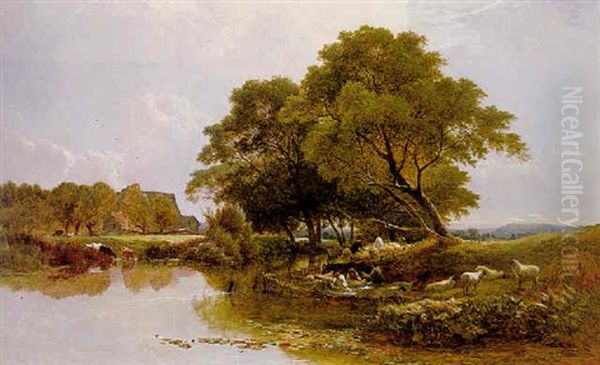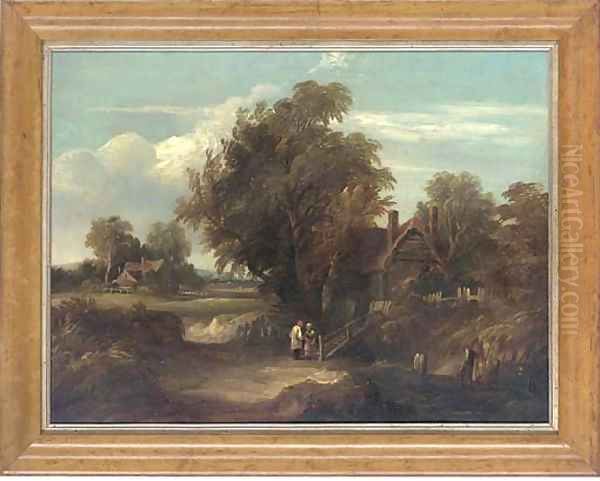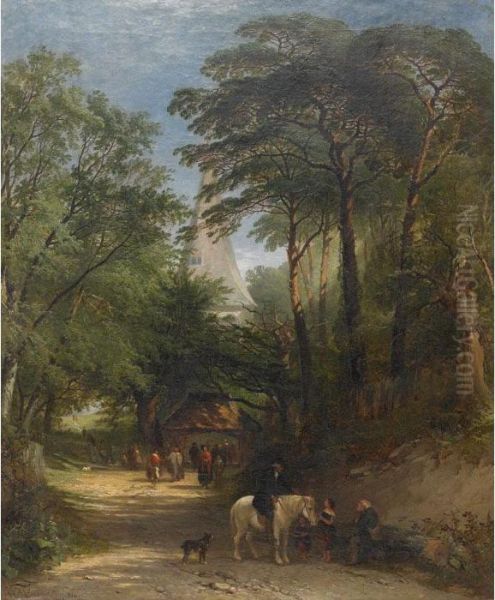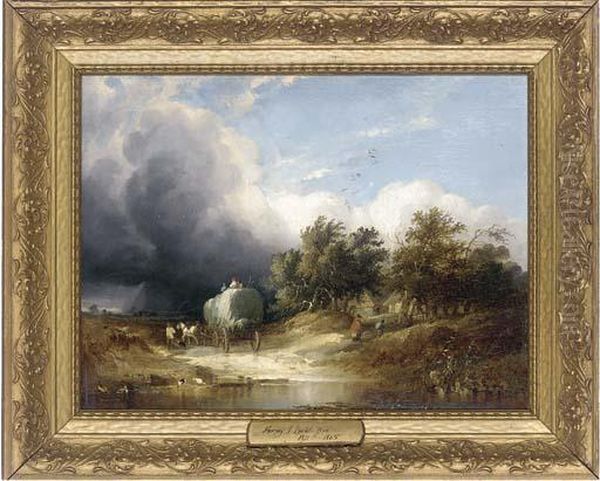Henry John Boddington stands as a significant figure within the rich tapestry of 19th-century British landscape painting. Active during the Victorian era, he captured the gentle beauty and tranquil essence of the English countryside, particularly the waterways and rural scenes of the Thames Valley and Surrey. As a prominent member of the Williams family of painters, his work is intrinsically linked to a specific artistic dynasty, yet he carved out his own identity, leaving behind a legacy of pleasing, light-filled canvases that continue to charm viewers today. His art offers a window into the Victorian appreciation for nature and the specific aesthetics of landscape representation during his time.
Early Life and Artistic Lineage
Born Henry John Williams in Thame, Oxfordshire, on October 14, 1811, the artist entered a world already steeped in artistic tradition. He was the sixth son of the notable landscape painter Edward Williams (1781-1855). Edward Williams himself was the son of an engraver and related to other artists, establishing a lineage that would become one of the most prolific artistic families in British history. Henry John grew up surrounded by art, with his father and elder brothers all pursuing careers as painters. This environment undoubtedly provided his earliest and most formative artistic education.
The Williams family produced a remarkable number of landscape painters, including Henry John's brothers: Edward Charles Williams, George Augustus Williams, Arthur Gilbert Frederick Williams (who signed as Arthur Gilbert), Sidney Richard Percy Williams (who signed as Sidney Richard Percy), and Alfred Walter Williams. Each developed variations on the family style, often focusing on similar picturesque subject matter found throughout England, Wales, and Scotland. This proliferation of artists within one family created a unique dynamic of shared influence and gentle competition.

A defining moment in establishing his individual artistic identity came with his marriage to Clarissa Eliza Boddington in 1832. To distinguish his work from that of his father and numerous brothers, he adopted his wife's maiden name. From then on, he signed his works and became known professionally as Henry John Boddington. This practical decision highlights the crowded nature of the art market and the specific challenge faced by members of the Williams clan in differentiating their individual outputs.
Artistic Development and Training
Unlike many of his contemporaries who sought formal training at the Royal Academy Schools or similar institutions, Boddington's primary artistic education appears to have come directly from his father, Edward Williams. He learned his craft through observation, practice, and paternal guidance within the family workshop. This method, sometimes referred to as the "Williams School" or likened to a "wilderness school," emphasized direct engagement with nature and the established conventions of picturesque landscape painting passed down through the family.
His early works, naturally, show the strong influence of his father's style, characterized by detailed foliage, carefully structured compositions, and an emphasis on the serene aspects of the British landscape. He quickly developed a proficiency in capturing the effects of light and atmosphere, particularly the soft, diffused light often found along riverbanks and in wooded glades. His initial subjects frequently centered on the familiar landscapes of Surrey and the banks of the River Thames, areas easily accessible from the family's base in Barnes, London.
Some sources mention study at the Royal Academy and even a period of study in Paris with artists like Carolus-Duran, Aimé Morot, Léon Glaire, Lucien Olivier Merson, and Raphael Collin. However, this information contrasts sharply with the more widely accepted narrative of his development primarily within the Williams family circle and his established timeline in England. While he certainly exhibited at the Royal Academy, formal enrollment as a student or extended Parisian study seems less documented and potentially conflated with another artist's biography. The core of his training remains rooted in the familial tradition established by Edward Williams.
Style and Subject Matter

Henry John Boddington's artistic style is firmly rooted in the Victorian landscape tradition, favouring realism and picturesque beauty over the dramatic sublimity explored by artists like J.M.W. Turner or the intense naturalism of John Constable. His paintings are often characterized by a gentle, lyrical quality, emphasizing tranquility and the harmonious relationship between humanity and nature. He excelled at depicting the play of light, particularly sunlight filtering through trees or reflecting off water, often employing a warm, golden palette to evoke specific times of day, like early morning or late afternoon.
His preferred subject matter consistently revolved around the English countryside. The River Thames was a recurring motif, captured in its various moods – from busy stretches with boats and riverside inns to quiet backwaters fringed with willows and reeds. He painted numerous views along its course, often including anglers, boatmen, or families enjoying the river, adding narrative interest and scale. Beyond the Thames, he explored the landscapes of Surrey, Kent, Wales, and Yorkshire, seeking out rustic cottages, watermills, wooded paths, and pastoral scenes with grazing cattle or sheep.
Boddington's compositions are typically well-structured, often employing traditional framing devices like foreground trees or riverbanks leading the viewer's eye into the scene. His rendering of foliage is detailed yet painterly, capturing the textures of leaves and bark. Water is treated with particular skill, conveying both its reflective qualities and its gentle movement. While figures are often present, they remain subordinate to the landscape itself, serving to animate the scene rather than dominate it. His overall approach aimed for a pleasing and accessible representation of nature's beauty.
Key Works and Themes
Among Boddington's most recognized and representative works is Sheep Washing (sometimes titled Sheep Bathing). This painting exemplifies many characteristic features of his style. It depicts a quintessential rural activity set within a lush, verdant landscape, likely beside a river or stream. The scene is bathed in a soft, slightly hazy light, suggesting perhaps the moments before or after a summer shower, a common atmospheric effect in his work. The composition carefully balances the figures and animals with the surrounding trees, water, and distant landscape, creating a harmonious whole. The painting captures the charm and peacefulness of English pastoral life, a theme that resonated strongly with Victorian audiences.

Other works further illustrate his thematic concerns and stylistic traits. Paintings like Wooden Cart often focus on rustic elements and rural labour within a picturesque setting, emphasizing the integration of human activity into the natural world. Camping by a Stream highlights the recreational aspect of the countryside, showing figures enjoying leisure time amidst nature, a popular Victorian pastime. Across his oeuvre, recurring themes include the beauty of waterways, the changing seasons, the tranquility of woodland interiors, and the gentle rhythms of rural existence.
His river scenes, such as On the Thames, Near Henley or views of Marlow and Pangbourne, showcase his ability to capture the specific character of different locations along the river. He often included details like locks, weirs, and distinctive architecture, grounding his picturesque views in recognizable topography. These works appealed to a growing interest in domestic tourism and the appreciation of Britain's own scenic landscapes.
Exhibition Career and Recognition
Boddington began exhibiting his work in London around 1837. He quickly gained recognition and became a regular contributor to the major London exhibitions. His paintings were frequently shown at the prestigious Royal Academy, the British Institution, and, most significantly, the Royal Society of British Artists (RBA) located on Suffolk Street. His consistent presence at these venues helped establish his reputation among collectors and the art-viewing public.
His affiliation with the RBA was particularly important. He was elected a member of the society in 1842, a testament to the regard in which his work was held by his peers. He became one of the RBA's most prolific exhibitors, often sending multiple works each year. This regular exposure ensured his name remained familiar and his paintings accessible to potential buyers. While perhaps not achieving the superstar status of some contemporaries, he built a successful and respected career.
Critical reception of Boddington's work during his lifetime was generally positive, if sometimes reserved. His paintings were often praised for their truthfulness to nature, their pleasing compositions, and their skillful handling of light. The influential art critic John Ruskin, known for his championship of detailed naturalism, reportedly commented favourably on Boddington's honesty and genuine love for the countryside depicted in his work. However, some critics occasionally found his work pleasant but lacking the 'passion' or innovative spark seen in the leading figures of the era. His style was seen as reliably competent and charming, fulfilling the public's desire for accessible and attractive landscape art.
Context: The Victorian Art World

Henry John Boddington worked during a dynamic period in British art history. The Victorian era saw landscape painting flourish, driven by several factors: the ongoing influence of Romanticism, a growing middle-class market for art, increased domestic travel facilitated by railways, and a certain nostalgia for the countryside amidst rapid industrialization. Boddington's art fit comfortably within this context, offering idyllic visions of rural England that appealed to urban dwellers.
He was a contemporary of giants like J.M.W. Turner (1775-1851) and John Constable (1776-1837), whose revolutionary approaches to light, atmosphere, and brushwork had already transformed landscape painting. While Boddington's style was less radical, he absorbed some of their lessons regarding atmospheric effects and the importance of direct observation, albeit translated into a more conventional, picturesque idiom. His work finds closer parallels with other successful Victorian landscape painters who focused on detailed, pleasing representations of nature.
These contemporaries included artists like Thomas Creswick (1811-1869), known for his similarly detailed depictions of English and Welsh scenery, often featuring rivers and streams. Clarkson Stanfield (1793-1867) excelled in marine painting and dramatic landscapes, while David Roberts (1796-1864) was famed for his topographical views of Britain, Europe, and the Near East. John Linnell (1792-1882), initially associated with William Blake, later achieved great success with his richly coloured pastoral landscapes, often depicting Surrey scenes similar to Boddington's. The legacy of the Norwich School, with artists like John Crome (1768-1821) and John Sell Cotman (1782-1842), also informed the broader landscape tradition.
Furthermore, Boddington worked during the rise of the Pre-Raphaelite Brotherhood (founded 1848), whose members, including John Everett Millais (1829-1896), William Holman Hunt (1827-1910), and Dante Gabriel Rossetti (1828-1882), advocated for intense detail and truth to nature, albeit often applied to historical or literary subjects as well as landscape backgrounds. While Boddington did not adopt their meticulous technique or moralizing intensity, the Pre-Raphaelite emphasis on detailed observation may have reinforced the existing Victorian taste for realism, which his work satisfied in its own way.
The Williams Family Connection
It is impossible to fully understand Henry John Boddington without considering his place within the Williams family of painters. His father, Edward Williams, was not only his primary teacher but also the patriarch of an artistic dynasty. The shared profession created a unique environment of mutual support and influence, but also necessitated differentiation. Henry John's adoption of the Boddington name was the most overt sign of this, but stylistic nuances also emerged among the brothers.

His brother Sidney Richard Percy (1821-1886) became perhaps the most commercially successful of the siblings, known for his expansive, often dramatic views of the Scottish Highlands and the Lake District, as well as Welsh river valleys. Arthur Gilbert (1819-1895) specialized in tranquil moonlit scenes and autumnal landscapes, developing a distinct atmospheric niche. George Augustus Williams (1814-1901) often painted Thames views and coastal scenes, sometimes with more nocturnal effects. Alfred Walter Williams (1824-1905) focused on detailed landscapes of the Thames, Wales, and Scotland.
While all shared a foundational style derived from their father, each brother cultivated specific subjects or atmospheric effects. Henry John Boddington distinguished himself through his consistent focus on the gentle, sunlit beauty of the southern English counties, particularly river scenes. His work often possesses a brighter palette and a more serene mood compared to the sometimes more dramatic or melancholic canvases of Percy or Gilbert. Studying the works of the various Williams family members side-by-side reveals both the strong family resemblance and the subtle individual artistic personalities that emerged.
Later Life and Legacy
Henry John Boddington continued to paint and exhibit prolifically throughout the 1840s, 1850s, and into the early 1860s. He maintained his popularity with the public and his position within the London art world, particularly through his contributions to the RBA exhibitions. His subjects remained consistent, focusing on the landscapes he knew and loved best. He resided for many years in Barnes, strategically located for accessing the Thames and the Surrey countryside.
His life appears to have been relatively stable, dedicated to his family and his art. He passed away relatively young, on April 11, 1865, at his home in Barnes, Surrey, at the age of 53. His death occurred at the height of his career, while he was still actively producing and exhibiting work.
Today, Henry John Boddington is remembered as a skilled and appealing painter of the Victorian era. While not considered a major innovator, his work holds an important place within the tradition of British landscape painting. His canvases capture a specific vision of England – peaceful, picturesque, and bathed in gentle light. They reflect the tastes and sensibilities of his time, offering charming glimpses into the 19th-century countryside. His paintings are held in numerous public and private collections, and they continue to be appreciated by art lovers and collectors for their technical competence, atmospheric charm, and faithful depiction of the English landscape. He remains a key figure within the remarkable story of the Williams family of painters.
Conclusion
Henry John Boddington's contribution to British art lies in his consistent and skillful portrayal of the English landscape's quieter beauties. As a member of the prolific Williams family, he navigated the challenge of establishing his own identity, achieving success through his focus on the Thames Valley and southern counties, rendered with characteristic attention to light and atmosphere. His works, like Sheep Washing, encapsulate the Victorian fondness for picturesque rural scenes. Though perhaps overshadowed by more revolutionary contemporaries like Turner or Constable, Boddington produced a significant body of work that was popular in its day and continues to offer a pleasing and historically valuable perspective on 19th-century landscape painting. His art remains a testament to the enduring appeal of the tranquil English countryside.